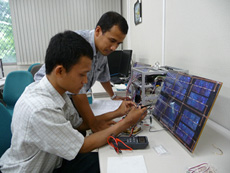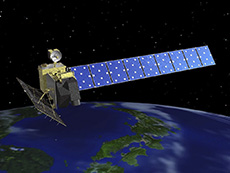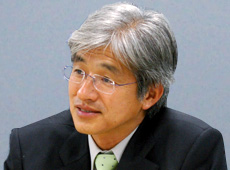Q. Tell us about the STAR program, which started this year.

Participants in the STAR program study a small-scale satellite system.
STAR stands for Satellite Technology for the Asia-Pacific Region. Asian space agencies have a great need for small satellites for environmental and disaster monitoring. So the possibility of international cooperation in the design and construction of small satellites has been under discussion at APRSAF for some time. Two years ago JAXA suggested an engineer training program for small satellite technology, and this year the project finally got off the ground.
Participants in the STAR program - engineers and researchers from Asian space agencies - will get together and initially study a 300 to 500 kilogram small satellite system. They are then scheduled to actually build an ultra-small satellite of 50 to 100 kilograms.
We set up an office for the STAR program on JAXA's Sagamihara Campus in April 2009, and formally started accepting participants from Asian countries on June 1. Participants from Indonesia and Thailand have already arrived in Japan. Currently, seven countries - Japan, South Korea, India, Indonesia, Thailand, Malaysia and Vietnam - are set to participate in the STAR program. Participants include instructors from Japan, South Korea and India. The goal is to train participants so they can make their own small satellites when they go back to their home countries. We also anticipate that they will develop a deeper understanding of each other's technology and cultures, and establish close personal networks, so they can cooperate effectively in the future on joint satellite projects.
Participants in the STAR program - engineers and researchers from Asian space agencies - will get together and initially study a 300 to 500 kilogram small satellite system. They are then scheduled to actually build an ultra-small satellite of 50 to 100 kilograms.
We set up an office for the STAR program on JAXA's Sagamihara Campus in April 2009, and formally started accepting participants from Asian countries on June 1. Participants from Indonesia and Thailand have already arrived in Japan. Currently, seven countries - Japan, South Korea, India, Indonesia, Thailand, Malaysia and Vietnam - are set to participate in the STAR program. Participants include instructors from Japan, South Korea and India. The goal is to train participants so they can make their own small satellites when they go back to their home countries. We also anticipate that they will develop a deeper understanding of each other's technology and cultures, and establish close personal networks, so they can cooperate effectively in the future on joint satellite projects.
Q. What are the anticipated advantages of the STAR program?
The goal of APRSAF has been to introduce attractive international cooperation to participating space agencies. To this end, JAXA wanted to respond to the higher needs for small satellites in Asia, and proposed the STAR program.
Small satellites are good to start with for countries that have never launched a satellite before. India and South Korea have already developed and launched small satellites, and are interested in providing their technology to foreign countries. Malaysia, Indonesia and Thailand have also started to develop small satellites. With all this activity, technological capability has been much improved in the region, and now is the ideal time for small satellite development. In the future, I think a process will be developed to share technology and to establish a system of satellites for disaster monitoring and environmental observation. For instance, Japan may be able use parts made in India and South Korea, or Indonesia can obtain and use data from a Japanese satellite. We are expecting the STAR program to lead to this type of international cooperation.
Small satellites are good to start with for countries that have never launched a satellite before. India and South Korea have already developed and launched small satellites, and are interested in providing their technology to foreign countries. Malaysia, Indonesia and Thailand have also started to develop small satellites. With all this activity, technological capability has been much improved in the region, and now is the ideal time for small satellite development. In the future, I think a process will be developed to share technology and to establish a system of satellites for disaster monitoring and environmental observation. For instance, Japan may be able use parts made in India and South Korea, or Indonesia can obtain and use data from a Japanese satellite. We are expecting the STAR program to lead to this type of international cooperation.
Q. How is APRSAF perceived among international organizations such as the United Nations?

Advanced Land Observing Satellite DAICHI (ALOS) , contributing satellite to the Sentinel Asia project.
As evidenced by the participation of Dr. Ciro Arévalo, chairman of the United Nations Committee on the Peaceful Uses of Outer Space (COPUOS), at last year's APRSAF-15 in Vietnam, the organization's activities are drawing international attention. The United Nations values the Sentinel Asia project particularly highly. We've been told that the UN is particularly interested in the use of space technology in disaster management and environmental protection. Sentinel Asia is due to begin cooperation with the United Nations Platform for Space-based Information for Disaster Management and Emergency Response (UN-SPIDER). Preparations for this are currently underway.
In addition, at a Disaster Risk Reduction Committee meeting last March, sponsored by the Economic and Social Commission for Asia and the Pacific (ESCAP), a regional commission of the United Nations, the Executive Secretary of ESCAP said, "From now on, we would like to carry out disaster and environment monitoring using space technology in cooperation with local space agencies."
In addition, at a Disaster Risk Reduction Committee meeting last March, sponsored by the Economic and Social Commission for Asia and the Pacific (ESCAP), a regional commission of the United Nations, the Executive Secretary of ESCAP said, "From now on, we would like to carry out disaster and environment monitoring using space technology in cooperation with local space agencies."
Q. What kind of responses have you received from European and American space agencies with respect to activities in Asia?
NASA participates in APRSAF, and has specifically commented that Sentinel Asia is very useful and effective. The Sentinel Asia system uses a common global platform and is available on any PC via the Internet. The initial cost is quite low. I think the efficiency of this system, which can be used by anybody, anywhere, is highly valued. Also attracting attention is the close cooperation among local disaster management organizations, in part through the Asian Disaster Reduction Center. JAXA has been cooperating closely with European countries and the United States, mainly via the International Space Station, but we are also making a fresh impression on Western space agencies as a leader of APRSAF.
Q. Is this cooperation between JAXA and Asian countries linked with Japan's international aid agency, Official Development Assistance (ODA)?
JAXA is working to promote long-term space utilization in the Asia-Pacific region in cooperation with ODA, which aims to contribute to economic and social development as well as improving technology in developing countries. In cooperation with ODA, we are helping monitor forests and peat fires in Indonesia, glacial lakes in Bhutan, etc. We are also working with ODA to train engineers from Asian countries who utilize the Earth observation data.
Q. What kind of benefits do you think the Japanese space program and aerospace industry receive through activities like APRSAF?

Through international programs such as APRSAF, we can exchange information on plans and priorities with space agencies from other countries. Through projects such as Sentinel Asia, there will be specific benefits such as data from disaster monitoring or information on water resource management. This benefits not just Japanese organizations but our counterparts all over Asia. Naturally, private-sector companies also take part in APRSAF, in order to find out about the needs and expectations of Asian countries, as well as provide information on what can be useful for these countries. In addition, we are anticipating that as engineers and researchers from other Asian countries become familiar with Japanese space technology through the STAR Program, the project will become a bridge between the Japanese space industry and other countries' space agencies.
Q. Is the circle of cooperation between Asian space agencies expanding through APRSAF?
APRSAF is asking participating countries and organizations to take the lead and suggest specific projects. India has offered its cooperation through its recovery capsules in space environment experiments. South Korea also actively participates in APRSAF. In such an environment, I think cooperation between Asian countries will strengthen in the future; for instance, satellites that carry out emergency observations for Sentinel Asia will be not only from Japan and India but also from South Korea. Each country will have an increased opportunity to take the initiative on space utilization.
Q. Is the circle of cooperation between Asian space agencies expanding through APRSAF?
APRSAF is asking participating countries and organizations to take the lead and suggest specific projects. India has offered its cooperation through its recovery capsules in space environment experiments. South Korea also actively participates in APRSAF. In such an environment, I think cooperation between Asian countries will strengthen in the future; for instance, satellites that carry out emergency observations for Sentinel Asia will be not only from Japan and India but also from South Korea. Each country will have an increased opportunity to take the initiative on space utilization.